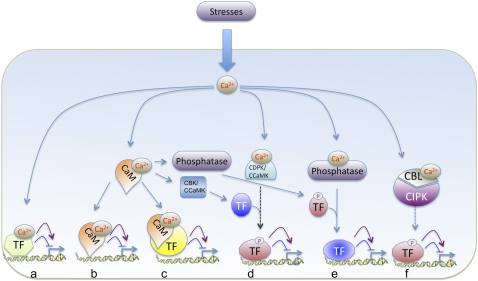Figure 1.
Signal-Induced Elevation of Cellular Calcium ([Ca2+]cyt and/or [Ca2+]nuc) Can Regulate Transcription by Different Mechanisms.
Elevated Ca2+ levels result in its binding to a Ca2+ sensor, which directly binds to specific DNA sequences and modulates gene expression (a and b). Activated calcium sensors (Ca2+/CaM or Ca2+/CML) interact with DNA binding proteins and modulate their activity resulting in altered transcription (c). Finally, an elevated level of calcium activates a protein kinase (CDPK, CBK, and/or CCaMK) either directly or through CaM or a protein phosphatase, which in turn phosphorylates or dephosphorylates a TF, respectively, resulting in activation or repression of transcription (d to f). Solid arrows indicate pathways with experimental evidence. Pathways lacking evidence are represented by broken arrows. Purple arrows indicate activation of gene expression; blue lines with a horizontal line represent repression.

